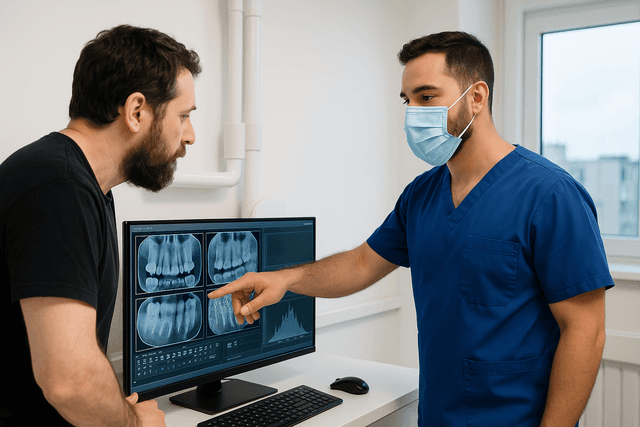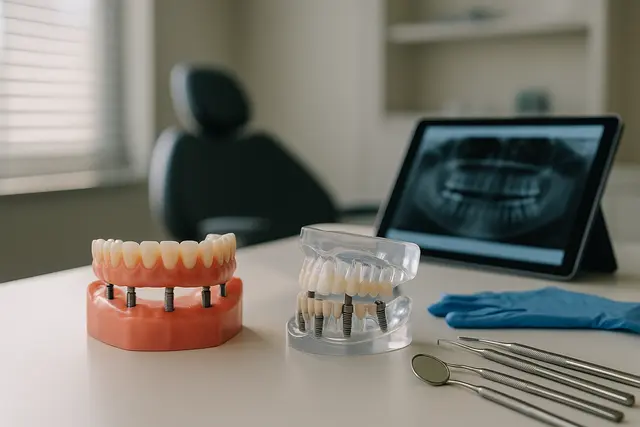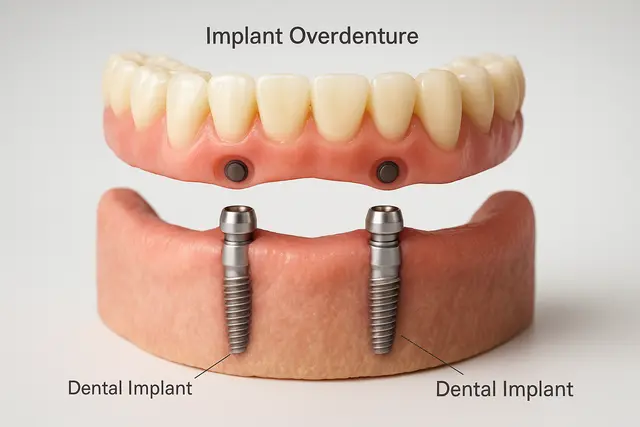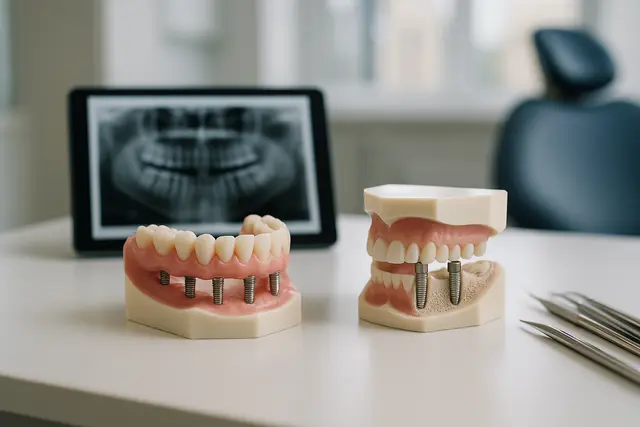Prosthodontics
5 min read
Oct 14, 2025
Bone Graft vs. Sinus Lift: What’s the Difference in Dental Restoration?
Missing teeth in your upper jaw can make dental implants a bit more complex, but that’s where procedures like bone grafts and sinus lifts come in. These treatments help rebuild lost bone and create a strong foundation for lasting implant success, ensuring your new smile looks and feels completely natural.

If you’re missing teeth in the back of your upper jaw and thinking about getting a dental implant, your dentist might mention something about needing a bone graft or a sinus lift. And if that leaves you with more questions than answers, you’re not alone. These two procedures sound intimidating, but they’re actually pretty common in modern dentistry.
Let’s walk through what a bone graft is, what a sinus lift does, and why one (or both) might be the secret weapon behind a strong, lasting dental implant. Spoiler alert: it all comes down to making sure there’s enough bone to hold your new tooth in place.
Bone Graft: Why It’s Often the First Step
A bone graft is a surgical procedure that adds bone material to areas of the jaw where bone is missing or too thin. Basically, it fills in the gaps, literally, so your dental implant has enough solid support to stay put for the long haul.
Bone grafting is performed when the jawbone has shrunk due to tooth loss, gum disease, or aging. If you've experienced bone loss, your dentist might recommend a type of bone graft before moving forward with implant placement.
There are a few different types of bone graft material, including:
Your own bone (called autografts)
Donor bone from a tissue bank (allografts)
Animal bone, usually from cows (xenografts)
Synthetic materials that stimulate new bone growth
Each has its pros and cons, and your dentist will help choose the best type of bone graft based on your unique case. The goal is always to build up the bone volume and bone density so you’ve got a strong foundation for dental implants.
Sinus Lift: When the Upper Jaw Needs Backup
Now, let’s talk sinus lifts. This procedure is specifically for the upper jaw, especially the back part, near your molars. Why? Because right above that area sits the maxillary sinus, a hollow space that can sometimes sag downward after tooth loss. And when that happens, there isn’t enough bone height in the upper jaw to support a dental implant.
A sinus lift, also known as sinus augmentation, solves this problem by literally lifting the sinus membrane and placing bone graft material underneath it. This creates the extra height and space needed to add bone to the upper jaw so the implant can be placed safely and securely later on.
So if your dentist says you’ve got insufficient bone height or bone loss in the upper jaw, and your sinus is creeping into the space where a dental implant would go, a sinus lift is likely the next step.
What’s Really Going On in These Procedures?
Whether we’re talking bone grafting in general or sinus lifts specifically, the common theme here is adding bone where it’s missing.
In both procedures, the graft is a surgical procedure that involves adding bone material to the jaw to stimulate new bone growth. Once placed, the bone graft material slowly integrates with your existing bone. Think of it like planting seeds in the garden, they need time to grow roots and become part of the landscape.
It’s worth noting that lifting the sinus membrane and placing a bone graft isn’t as scary as it sounds. The procedure is done under local anesthesia, and while recovery takes a few months, most patients say the discomfort is minimal and totally worth the results.
Dentistry Meets Engineering: Crafting the Perfect Support System
Modern dentistry is a lot like structural engineering. If you’re building a house, you wouldn’t put the roof on before laying the foundation, right? The same principle applies when placing a dental implant.
For the implant to work, it needs a stable foundation made of healthy bone. Without adequate bone support, the implant might fail to fuse properly or become unstable over time. And nobody wants a wobbly tooth.
This is why procedures like bone grafting and sinus lifts aim to create enough bone height and bone volume in the area of the jaw where the implant will go. It’s all about setting the stage for long-term implant success.
Sinus Lift and Bone Graft: Why They Often Go Hand in Hand
Sometimes patients need both procedures: a sinus lift and bone graft. This often happens in the upper jaw where the bone is thin, and the sinus cavity has expanded due to lost bone.
In these cases, the dentist or oral surgeon will perform a sinus lift and bone graft in a single procedure. They’ll raise the sinus floor, carefully move the sinus membrane, and place bone graft material into the space to augment bone volume and density.
This combo approach builds a strong foundation for dental implants while also solving the issue of a sagging sinus cavity. It’s a one-two punch that sets you up for success.
Differences Between Sinus Lift and Bone Graft
Still confused? Here’s a quick breakdown of the key differences between sinus lift and bone graft procedures:
A bone graft can be done anywhere in the jaw where bone is missing or too thin. It’s the broader term for adding bone material.
A sinus lift is a special kind of bone grafting performed only in the upper jaw, near the molars and premolars, to lift the sinus membrane and add bone below it.
So technically, a sinus lift is a type of bone graft, but not all bone grafts are sinus lifts. Make sense?
How to Know What’s Right for You
If you’re considering dental implants, your dentist will evaluate the area with X-rays or a CT scan to assess bone density for dental implant placement. They’ll check if there’s sufficient bone, or if a sinus lift or bone graft is needed.
If there isn’t enough bone height in the upper jaw, or the bone density is insufficient, they may recommend placing a bone graft or doing a sinus lift procedure first.
It’s also possible your dentist will find enough bone and say you’re good to go without any extra steps. Lucky you! But don’t stress if you need a little help, bone grafting is a procedure that’s done every day, and the success rate for dental implants is sky-high when the groundwork is done right.
Sinus Lift vs. Bone Graft: What’s the Better Option?
It’s not really a matter of one being better than the other. Instead, it’s about what your jaw actually needs.
If the problem is thin bone anywhere in the mouth, you’ll likely need a bone graft.
If the issue is in the upper jaw, close to the maxillary sinus, and the bone height isn’t cutting it, then a sinus lift is needed.
And sometimes? You need both. But whether you’re placing a bone graft alone or doing a sinus lift and bone graft combo, the goal is the same: create a strong foundation for dental implants that lasts.
What Is the Main Difference Between a Bone Graft and a Sinus Lift?
The key difference is location and purpose. A bone graft is used anywhere in the jaw to rebuild bone volume where it’s been lost, usually due to aging, gum disease, or tooth loss. A sinus lift, on the other hand, is a specialized type of bone graft done only in the upper jaw near the molars and premolars. It involves lifting the sinus membrane to make room for new bone material, especially when the sinus cavity has dropped too low for an implant.
When Do You Need a Sinus Lift Instead of a Regular Bone Graft?
You typically need a sinus lift if you're missing teeth in the back upper jaw and your dentist finds that the bone height is insufficient due to the proximity of your sinus cavity. When the sinus is too low or the bone is too thin to support an implant securely, a sinus lift creates the necessary space and bone height by gently raising the sinus floor and placing a graft underneath.
Can You Have a Sinus Lift and Bone Graft at the Same Time?
Yes, and it’s actually quite common. When there’s not enough bone in the upper back jaw and the sinus has expanded downward, a dentist may perform both procedures during the same surgery. The sinus membrane is lifted, and bone graft material is placed beneath it to increase height and volume, setting a solid foundation for future dental implants.
How Do You Know If You Need a Bone Graft or Sinus Lift Before Implants?
Your dentist will use X-rays or a CT scan to evaluate the bone in your jaw. If the bone density or volume is too low, especially in the upper jaw near the sinuses, a sinus lift or bone graft may be required before implants can be placed. These procedures aren’t unusual and are often the first step toward ensuring your dental implant has long-term stability and success.
Read Next
Related Posts

Prosthodontics
Implant Supported Dentures Overview
Missing teeth can impact more than just your smile, they can affect your confidence, comfort, and even your diet. Fortunately, modern dentistry offers a solution that’s both secure and natural-looking: implant-supported dentures. This innovative approach blends the stability of implants with the convenience of dentures to create a long-lasting, life-improving upgrade.
5 min read
Oct 29, 2025

Prosthodontics
Implant Overdentures Explained: The Hybrid Solution to Missing Teeth
Missing teeth can impact everything from your ability to eat to your self-confidence. While traditional dentures have long been a go-to solution, they often fall short in comfort and stability. Implant overdentures offer a modern alternative that combines the security of dental implants with the convenience of removable dentures, a true upgrade for those looking to reclaim their smile.
6 min read
Oct 29, 2025

Prosthodontics
Implant Retained Dentures Explained
Considering implant-retained dentures? You're not alone. As modern dentistry evolves, more people are turning to this secure, natural-feeling alternative to traditional dentures. This guide will walk you through what they are, how they work, and why they might be the solution you've been looking for.
4 min read
Oct 28, 2025
Don’t have time to research every dentist around you?
See why 30k+ patients trusted us